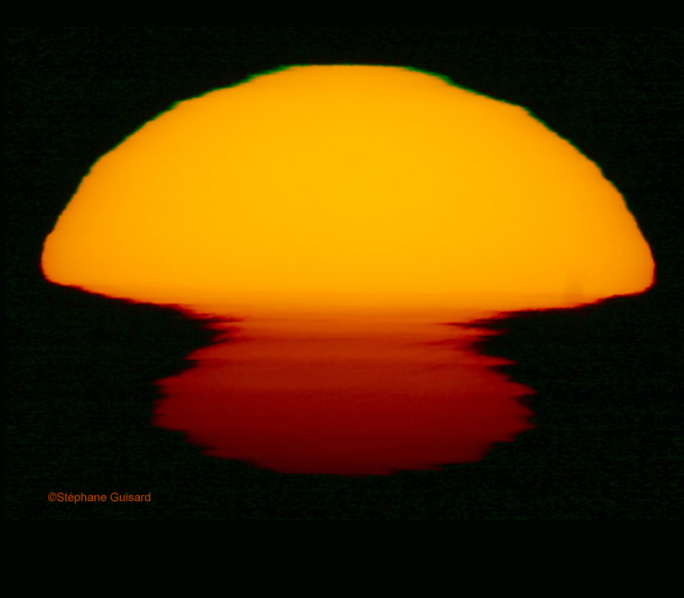Paranal Sunset Mirage
Paranal Sunset Mirage: A Spectacular Atmospheric Phenomenon
When it comes to atmospheric optics, the Paranal Sunset Mirage is a truly mesmerizing sight. Located in the Chilean Atacama Desert, the Paranal Observatory sits at an elevation of 2600m, offering a breathtaking view of the Pacific Ocean just 12km to the west. This unique geographical location sets the stage for temperature inversions, where cool air beneath warmer air over the ocean frequently creates mirages during sunset, resulting in extreme distortions and even elusive green flashes.
The Paranal Sunset Mirage has been captured in stunning detail by Stéphane Guisard, a skilled astrophotographer who had the privilege of witnessing this awe-inspiring spectacle firsthand. His images, taken from the ESO Paranal Observatory, showcase the remarkable beauty and complexity of this atmospheric phenomenon.
In this particular photograph, we can observe the sun partially obscured by a highly structured inversion layer, which gives rise to a mock-mirage effect. The inversion layer slices the lower disk of the sun into multiple images, creating a captivating visual display. The mirage further enhances this effect by vertically magnifying the green rim of the sun, which is caused by the stronger refraction of green light compared to red.
To fully appreciate the Paranal Sunset Mirage, it's important to understand the science behind it. Temperature inversions occur when a layer of cool air becomes trapped beneath a layer of warmer air. In this case, the cool air is situated over the ocean, while the warmer air resides above it. As sunlight passes through these varying air masses, it undergoes refraction, causing the light rays to bend and deviate from their original path.
During sunset, when the angle of the sun is lower in the sky, these bent rays of sunlight interact with the inversion layer, giving rise to mirage-like effects. The temperature gradient within the inversion layer causes the light to refract differently at different heights, resulting in the slicing and distortion of the sun's disk. The mirage effect occurs due to the bending of light rays at different angles, creating an illusion of multiple images and intensifying the green rim.
The green rim itself is a consequence of the differential refraction of light. Green light, having a shorter wavelength than red light, is refracted more strongly as it passes through the atmosphere. This stronger refraction causes the green light to be concentrated around the edge of the sun's disk, creating a distinct green rim. When combined with the mirage's vertical magnification, this green rim becomes even more pronounced, adding to the overall spectacle.
It's important to note that witnessing the Paranal Sunset Mirage is a rare occurrence, as it relies on specific atmospheric conditions. Temperature inversions need to be present, along with a clear line of sight between the observer and the ocean. Furthermore, the mirage effect and green flashes are fleeting moments that require precise timing and luck to capture.
In conclusion, the Paranal Sunset Mirage is a captivating atmospheric phenomenon that showcases the intricate interplay between light and air. The unique geographical location of the Paranal Observatory in the Chilean Atacama Desert provides the perfect vantage point for witnessing this extraordinary spectacle. Through the lens of talented astrophotographers like Stéphane Guisard, we are able to appreciate the intricate details and ethereal beauty of this natural phenomenon. While rare and elusive, the Paranal Sunset Mirage serves as a reminder of the wonders that can occur when nature and optics converge.

Paranal Sunset Mirage imaged by Stéphane Guisard (images) from ESO Paranal Observatory in the Chilean Atacama Desert. ©St�phane Guisard, shown with permission.
Paranal Observatory, the site of four advanced optically linked 8.2m telescopes, is 2600m high and overlooks the Pacific Ocean 12km to the west.
Temperature inversions, cool air beneath warmer, over the ocean frequently mirage its sunsets to give extreme distortions and green flashes.
Here the sun is seen partially through a highly structured inversion layer to produce a mock-mirage slicing the lower disk into multiple images.
At top, the stronger refraction of green light compared to red gives the disk its green rim, strengthened slightly by the mirage vertical magnification.
Note: this article has been automatically converted from the old site and may not appear as intended. You can find the original article here.
Reference Atmospheric Optics
If you use any of the definitions, information, or data presented on Atmospheric Optics, please copy the link or reference below to properly credit us as the reference source. Thank you!
-
<a href="https://atoptics.co.uk/blog/paranal-sunset-mirage/">Paranal Sunset Mirage</a>
-
"Paranal Sunset Mirage". Atmospheric Optics. Accessed on November 26, 2024. https://atoptics.co.uk/blog/paranal-sunset-mirage/.
-
"Paranal Sunset Mirage". Atmospheric Optics, https://atoptics.co.uk/blog/paranal-sunset-mirage/. Accessed 26 November, 2024
-
Paranal Sunset Mirage. Atmospheric Optics. Retrieved from https://atoptics.co.uk/blog/paranal-sunset-mirage/.